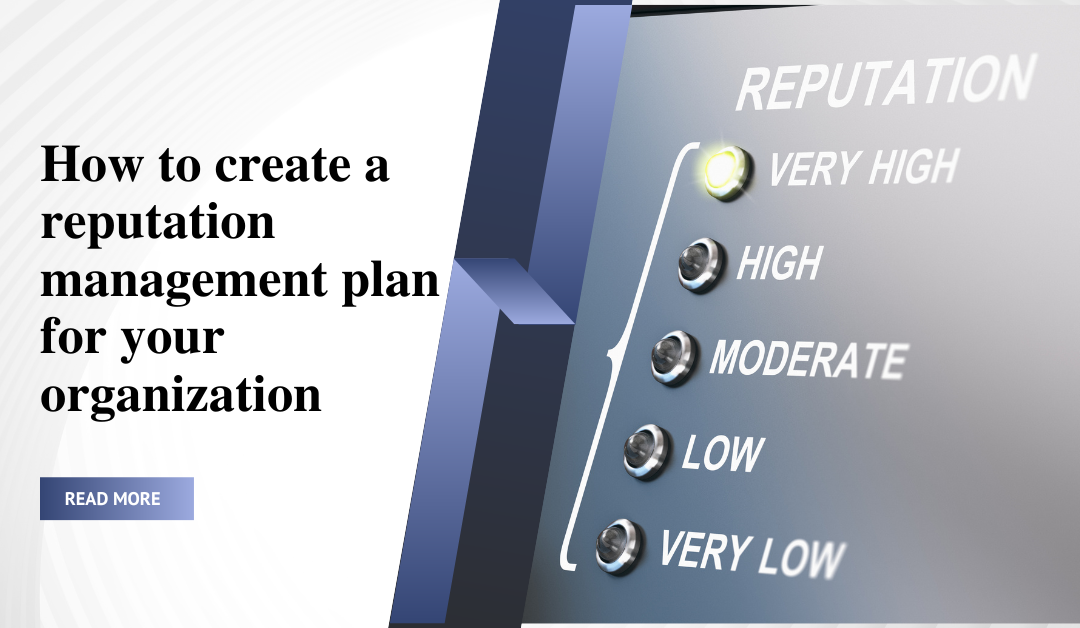In today’s digital age, a strong reputation can make or break an organization. With the widespread use of online platforms, social media, and customer review websites, it’s become easier than ever for customers to publicly share their experiences with businesses. While positive feedback can boost a company’s reputation, negative reviews, and comments can quickly damage it. This is why reputation management has become an essential aspect of any organization’s overall marketing strategy. In this article, we will discuss how to create a reputation management plan for your organization. We will cover topics such as assessing your current reputation, setting reputation goals, developing a reputation management strategy, implementing the plan, and more. By following the steps outlined in this article, you can proactively manage your organization’s reputation and mitigate any potential damage.
Assessing Your Current Reputation
To effectively manage your organization’s reputation, you must first understand your current standing in the eyes of your customers and stakeholders. Here are some steps you can take to assess your current reputation:
- Identify your organization’s current reputation: Start by conducting a thorough audit of your organization’s existing reputation. Gather feedback from customers and stakeholders, monitor social media mentions, and review online reviews and comments. This will help you understand your organization’s current standing and identify areas for improvement.
- Evaluate your organization’s online reputation: In today’s digital age, online reputation is just as important as offline reputation. Conduct a search for your organization’s name and review the results. Take note of any negative reviews or comments and identify the sources of these comments. This will help you determine which online platforms require the most attention.
- Review customer feedback and complaints: Reviewing customer feedback and complaints is an important part of assessing your organization’s reputation. It can help you identify common issues and areas for improvement. Pay attention to recurring complaints or negative feedback, as these are the areas that require immediate attention.
By assessing your organization’s current reputation, you can get a better understanding of what needs to be improved and develop a targeted reputation management plan.
Setting Reputation Goals
Once you have assessed your organization’s current reputation, the next step is to set reputation goals. Here’s how to do it:
- Define reputation goals: Start by defining what you want to achieve with your reputation management plan. Do you want to increase customer satisfaction? Improve your online reputation? Enhance brand visibility? Define clear and measurable goals that align with your organization’s overall objectives.
- Identify key stakeholders and their expectations: Identify the key stakeholders who have a vested interest in your organization’s reputation. These may include customers, employees, investors, suppliers, and partners. Determine their expectations and concerns, and ensure that your reputation goals align with their needs.
- Determine metrics for success: Once you have defined your reputation goals, determine the metrics that you will use to measure success. For example, if your goal is to improve your online reputation, you may track the number of positive reviews or social media mentions. If your goal is to increase customer satisfaction, you may track customer feedback and complaints.
By setting clear reputation goals and identifying key stakeholders and metrics for success, you can ensure that your reputation management plan is focused and effective.
Developing a Reputation Management Strategy
After setting reputation goals, the next step is to develop a reputation management strategy that will help you achieve those goals. Here are some steps you can take:
- Create a crisis management plan: Reputation crises can happen to any organization. It’s important to have a plan in place to handle them. Identify potential reputation risks and develop a crisis management plan that outlines the steps you will take to mitigate any damage.
- Define the organization’s tone and voice: Your organization’s tone and voice should be consistent across all communication channels, whether it’s social media, email, or customer service. Define the tone and voice that you want to use to communicate with customers and stakeholders.
- Develop a content strategy: Creating and sharing valuable content can help improve your organization’s reputation. Develop a content strategy that aligns with your reputation goals and tone. Ensure that your content provides value to your target audience.
- Establish a response protocol: Determine how you will respond to positive and negative feedback, and who will be responsible for responding. Establish a protocol for responding to complaints, and ensure that all responses are timely, respectful, and empathetic.
By developing a comprehensive reputation management strategy that includes a crisis management plan, a defined tone and voice, a content strategy, and a response protocol, you can ensure that your organization’s reputation is protected and improved.
Implementing Your Reputation Management Plan
Once you have developed a reputation management strategy, it’s time to implement the plan. Here are some steps you can take:
- Assign responsibilities: Assign responsibilities to team members for each aspect of the plan. This can include monitoring online mentions, responding to feedback, creating content, and managing crises. Ensure that each team member understands their role and is equipped with the necessary tools and resources.
- Monitor online mentions: Monitor online mentions of your organization regularly to stay on top of any issues that may arise. Use social media monitoring tools and Google Alerts to keep track of online mentions. Respond to comments and reviews promptly.
- Create and share valuable content: Develop content that aligns with your reputation goals and share it across all relevant channels. This could include blog posts, social media updates, videos, and infographics. Ensure that your content is relevant, valuable, and engaging.
- Respond to feedback: Respond promptly and professionally to all customer feedback, both positive and negative. Use the response protocol that you developed earlier and ensure that all responses are respectful, empathetic, and on-brand.
- Continuously evaluate and adjust: Continuously evaluate the effectiveness of your reputation management plan and adjust it as necessary. Monitor your progress toward your reputation goals and adjust your strategies based on feedback from customers and stakeholders.
By implementing your reputation management plan and continuously evaluating and adjusting it, you can improve your organization’s reputation and protect it from potential damage.
Final Thoughts
Creating a reputation management plan is crucial for any organization that wants to protect and improve its reputation. By assessing your current reputation, setting clear goals, developing a comprehensive strategy, and implementing the plan, you can ensure that your organization’s reputation is protected and enhanced.
Remember, your reputation is your most valuable asset. Investing in reputation management can have a significant impact on your bottom line. By taking a proactive approach to reputation management, you can prevent potential crises and position your organization as a trusted and reputable brand.
At DarkSky Digital, we specialize in reputation management and can help your organization develop a comprehensive plan to protect and enhance your reputation. Contact us today to learn more about our reputation management services and how we can help you achieve your reputation goals.
Read more of our posts here:
- Understanding the Basics of Pay-Per-Click Advertising: A Beginner’s Guide

- 5 Types of Content Every Marketer Should Know About

- The Impact of Customer Reviews on Your Online Reputation

- Measuring the ROI of Your Social Media Marketing Campaign: Unraveling the Secrets to Digital Success

- Content Marketing vs. Traditional Advertising: Which is More Effective?

- Title: The Future of SEO: Unlocking the Secrets to Digital Success


